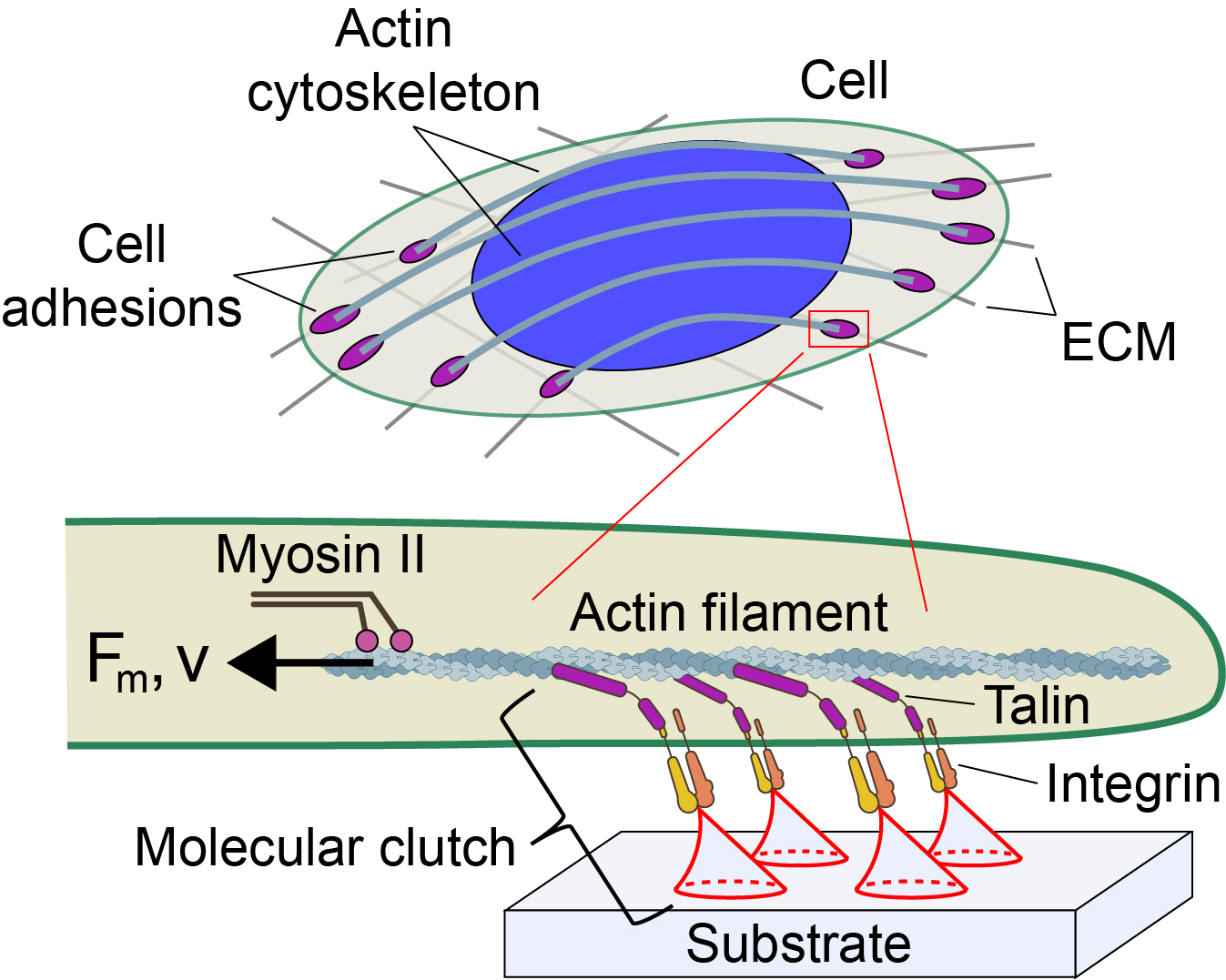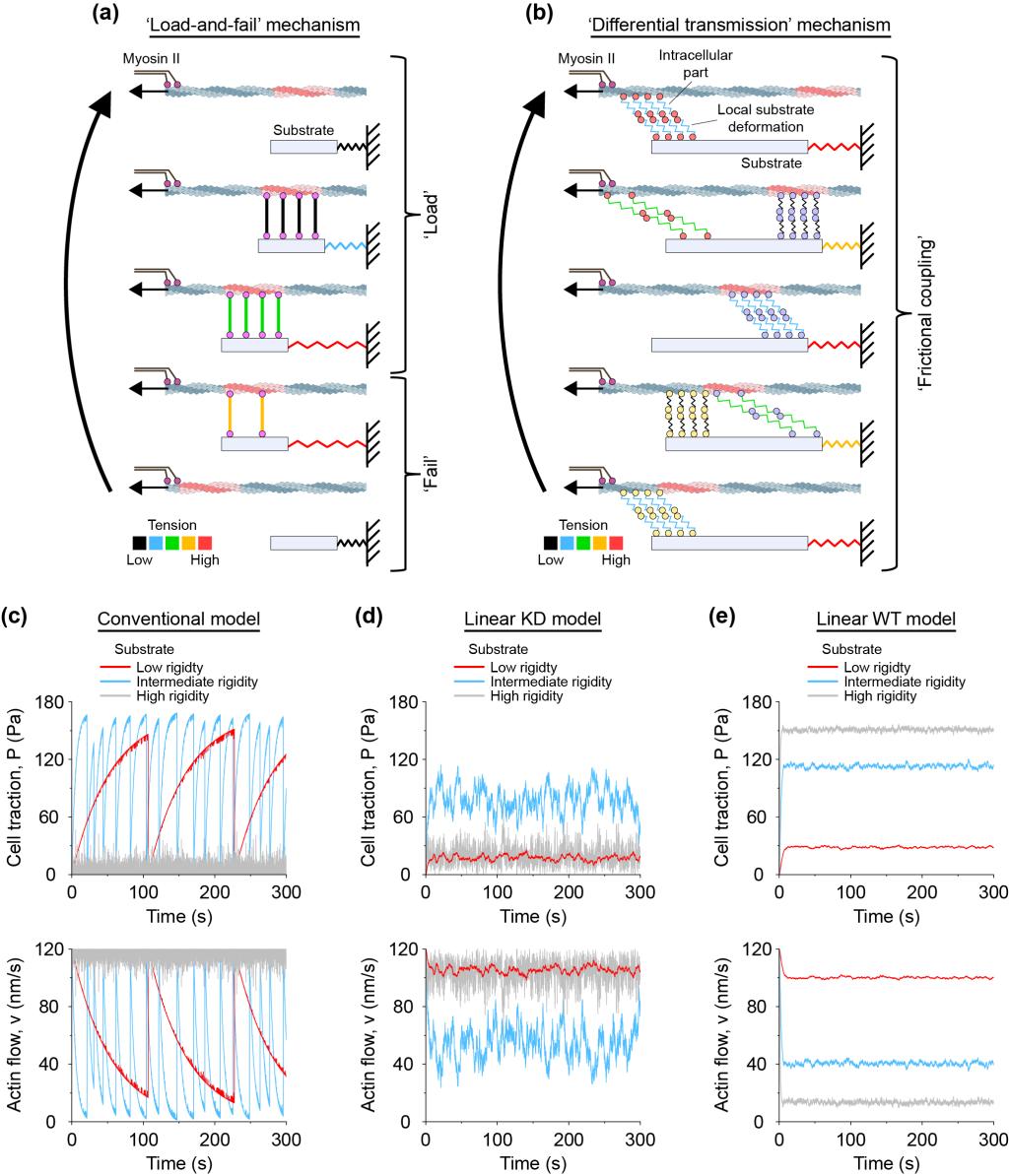
近日,深圳湾实验室Artem Efremov课题组在Nature Physics上发表了题为"Elastic properties of force-transmitting linkages determine multistable mechanosensitive behaviour of cell adhesion" 的研究论文。该研究揭示了机械转导蛋白的弹性特性在细胞粘附多稳态机械敏感行为中的关键作用。本研究中,研究人员构建了一个半解析模型,用以整合单个分子离合器组件的力响应数据,从而能够精准预测Tension-gauge-tether(TGT)实验所测得的分子离合器力加载速率。同时,该模型也能够解释细胞收缩性、配体密度以及Vinculin蛋白突变体对细胞粘附机械敏感行为的影响。
Perception of mechanical signals by living cells is important for the regulation of many cellular processes, such as cell growth, movement and differentiation, which are critical for normal cell function, and which exhibit abnormalities in the development of cancer and cardiovascular diseases. Since the discovery of the mechanosensitive behavior of cell adhesion complexes, several potential molecular mechanisms have been proposed to explain this phenomenon. However, each of the proposed mechanisms focuses on a single pathway, without providing a clear, holistic picture of how these mechanisms work together to endow cell adhesion complexes with a mechanosensitive function.
活细胞对机械信号的感知在调控细胞生长、迁移、分化等诸多过程中都起着关键作用。这些过程对维持细胞正常功能至关重要,功能异常则可能引发癌症及心血管疾病。为阐释细胞粘附复合物的机械敏感特性,研究人员已提出多种分子机制。然而,这些理论机制多聚焦于单一作用途径,尚未清晰、全面地揭示这些机制如何协同作用,进而调节细胞粘附复合物的机械敏感特性。
Given the overall complexity of the processes involved in the formation, shaping and mechanotransduction of cell adhesion complexes, this makes the problem of understanding the mechanosensitive behavior of cell adhesion one of the most challenging tasks in the mechanobiology field. This is where Artem’s research group began its study, with the main goal of making sense of the experimental observations accumulated to date.
鉴于细胞粘附复合物在形成及机械转导过程中所呈现出的复杂性,理解其机械敏感行为成为了力学生物学领域最具挑战的任务之一。Artem团队以此为切入点,以积累的实验数据为基础,旨在系统地阐释这些现象的内在机制。
To fill this gap, Artem’s group sought to develop a semi-analytical model incorporating experimentally measured force-response of major cell adhesion proteins that could accurately predict the force-loading rates of molecular links connecting the actin cytoskeleton to adhesion receptors (aka ‘molecular clutches’ [Figure 1]), which were recently measured in tension-gauge-tether experiments. The aim of the model was to bridge the mechanosensitive behaviour of cell adhesion complexes studied at the cellular level with mechanotransduction events occurring at the single-molecule level mediated by the core protein components of molecular clutches, such as talin and vinculin, to gain insights into the potential role of cell contractility, extracellular matrix ligand density, and vinculin mutants on the mechanosensitive behaviour of cell adhesion.
Artem 团队构建的半解析模型整合了主要细胞粘附蛋白的力响应数据,能够精准预测连接肌动蛋白细胞骨架与粘附受体(即“分子离合器”,见图1)的力加载速率。该模型将细胞的机械敏感行为与核心蛋白的机械特性联系起来,从而深入解释细胞收缩性、细胞外基质密度和vinculin突变体对细胞粘附机械敏感行为的潜在作用。

Figure 1. Molecular clutches.
Compared to previous efforts, this study has several key innovations that improve the current understanding of the molecular mechanism of cell mechanosensing:
相较于以往的研究,本研究具备以下创新点:
1.Developed semi-analytical model incorporates the nonlinear elastic properties of molecular clutch proteins, such as talin, measured in single-molecular manipulation experiments, allowing accurate representation of the mechanosensitive behavior of the components of cell adhesion complexes.
1.所构建的半解析模型整合了单分子实验中测得的分子离合蛋白(如Talin蛋白)的非线性弹性特性数据,从而能够准确表征细胞粘附复合物各组分的机械敏感行为。
2.In contrast to previous theoretical studies, the model correctly predicts the physiological values of experimental observables, such as the force-loading rate of molecular clutches and their average tension, which are in good agreement with recently published single-molecule tension-gauge tether experiments, suggesting that the model is capable of bridging cellular mechanosensing processes at the molecular and cellular levels.
2.该模型能够准确预测一系列生理值,如分子离合器的力加载速率及其平均张力,这些预测值与近期发表的TGT实验结果高度吻合,表明该模型能够在分子与细胞层面之间建立连接。
3. The developed model predicted that the density of myosin II motors in fibroblast cells may be regulated by the density of extracellular matrix ligands through a feedback loop, influencing mechanosensitive cell adhesion behavior, which was successfully confirmed by the experiments performed in the same study.
3. 该模型预测,成纤维细胞中myosin II马达蛋白的密度会借助反馈机制,受到细胞外基质配体密度的调控,进而对细胞的机械敏感黏附行为产生影响。
4. The model was also able to accurately predict the kinetics of talin and vinculin accumulation in focal adhesions and the time-dependent change in the size of focal adhesion during their maturation, which were measured in living cells and described in the same study.
4. 该模型能够精准预测黏着斑中Talin蛋白和Vinculin蛋白的积累动力学特征,以及黏着斑在成熟过程中的大小变化。
5. Using the model, Artem’s group demonstrated that elastic behavior of the main molecular clutch components, such as talin, is critical for the mechanical response of cell adhesion complexes and force transmission between the substrate and the cell cytoskeleton. As predicted by the model, high elasticity of these components allows substrate and actin filaments to move independently while maintaining a stable mechanical coupling between them via differential transmission mechanism mediated by molecular clutches – a result, which was found to be in good agreement with experimental observations [Figure 2].
5. Artem团队借助该模型证明,主要分子离合组件(如 Talin蛋白)的弹性行为对于细胞粘附复合物的机械响应以及基底与细胞骨架之间的力传递至关重要。正如模型所预测的,这些组件的高弹性使得基底和肌动蛋白丝能够独立移动,同时通过分子离合器介导的差速传递机制,在二者之间维持稳定的机械耦合。这一结果与实验观测结果高度吻合(见图2)。

Figure 2. 'Load-and-fail' mechanism versus 'differential transmission' mechanism
In the near future, Artem’s group intends to further refine the model by including a description of the phase-separation processes involved in the formation and shaping of cell adhesion complexes, as well as force-induced reorganization on of the actin cytoskeleton, in order to provide further understanding of the molecular mechanisms involved in the regulation of the mechanosensitive behaviour of cell adhesion complexes, which plays a leading role in all cell migration-dependent processes.
未来,Artem团队计划进一步完善该模型,纳入细胞粘附复合物形成过程中的相分离机制,以及力诱导的肌动蛋白细胞骨架重组过程。此举旨在深入揭示调控细胞粘附复合物力敏感行为的分子机制,该机制在细胞迁移相关过程中发挥重要作用。
Liu Ping, a former research assistant in Artem's group, and Wang Qiuyu, a joint Ph.D. student from the University of Hong Kong, are co-first authors of the study. The co-corresponding authors are Artem Yefremov, Principal Investigator at Shenzhen Bay Laboratory, and Yao Mingxi, Assistant Professor at Southern University of Science and Technology.
Artem课题组研究助理(前)刘萍和香港大学联培博士生王秋钰为论文共同第一作者。深圳湾实验室特聘研究员Artem Yefremov和南方科技大学助理教授姚明曦为论文共同通讯作者。
Artem’s group has a long history of research in single-molecule biophysics and cellular mechanobiology, using single-molecule manipulation techniques (e.g. optical tweezers/magnetic tweezers) and theoretical modeling, with a particular focus on areas such as mechanical regulation of the cytoskeleton, chromatin organization, and molecular mechanisms of mechanotransduction. The group is currently leading three innovative interdisciplinary projects:
Artem课题组长期致力于单分子生物物理学与细胞力学生物学研究,运用单分子操纵技术(如光镊/磁镊),开发建构理论模型,围绕细胞骨架力学调控、染色体动态结构及机械信号转导机制等方向展开工作。该团队目前正开展三项创新性跨学科研究:
1.Experimental-theoretical study of the molecular mechanisms involved in the regulation of nucleus size and the potential effect of the latter on chromatin organization in living cells.
1.通过实验与理论计算相结合的研究方法,研究调控活细胞核大小的分子机制,及其对活细胞染色质组织的潜在影响。
2.Investigation of mechanosensitive molecular pathways underlying the activation of cell signalling cascades involved in the guidance of cell migration.
2.细胞迁移信号通路分子机制研究。
3.Study of molecular mechanisms involved in mediating and regulating the mechanosensitive behaviour of cell adhesion.
3.细胞粘附的分子机制研究。
原文信息:
Elastic properties of force-transmitting linkages determine multistable mechanosensitive behaviour of cell adhesion
供稿 | Artem课题组
编辑 | 鲍 鲍
责编 | 远 山
欢迎投稿、建议 | media@szbl.ac.cn

 粤公网安备44031102000926号
粤公网安备44031102000926号